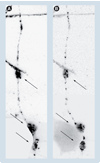Is abnormal axonal transport a cause, a contributing factor or a consequence of the neuronal pathology in Alzheimer's disease?
- PMID: 20076770
- PMCID: PMC2805861
- DOI: 10.2217/fnl.09.54
Is abnormal axonal transport a cause, a contributing factor or a consequence of the neuronal pathology in Alzheimer's disease?
Abstract
Axonal transport, the process by which membrane-bound organelles and soluble protein complexes are transported into and out of axons, ensures proper function of the neuron, including that of the synapse. As such, abnormalities in axonal transport could lead to neuronal pathology and disease. Similar to many neurodegenerative diseases, axonal transport is deficient in Alzheimer's disease (AD), a neurodegenerative brain disorder that affects old-age humans and is characterized by the deterioration of cognitive function and progressive memory loss. It was proposed that the synaptic pathology and neuronal degeneration that develops in AD could be caused by an abnormal axonal transport, and that the mutated proteins that cause early-onset AD, as well as the genetic variants that confer predisposition to late-onset AD might somehow impede axonal transport. This paper analyzes the data that support or contradict this hypothesis. Together, they indicate that, although abnormalities in axonal transport are part of the disease, additional studies are required to clearly establish to what extent deficient axonal transport is the cause or the effect of the neuronal pathology in AD, and to identify mechanisms that lead to its perturbation.
Figures





Similar articles
-
Regulation of Synaptic Amyloid-β Generation through BACE1 Retrograde Transport in a Mouse Model of Alzheimer's Disease.J Neurosci. 2017 Mar 8;37(10):2639-2655. doi: 10.1523/JNEUROSCI.2851-16.2017. Epub 2017 Feb 3. J Neurosci. 2017. PMID: 28159908 Free PMC article.
-
Mitochondrial traffic jams in Alzheimer's disease - pinpointing the roadblocks.Biochim Biophys Acta. 2016 Oct;1862(10):1909-17. doi: 10.1016/j.bbadis.2016.07.010. Epub 2016 Jul 25. Biochim Biophys Acta. 2016. PMID: 27460705 Review.
-
Tau accumulation in the retina promotes early neuronal dysfunction and precedes brain pathology in a mouse model of Alzheimer's disease.Mol Neurodegener. 2017 Aug 3;12(1):58. doi: 10.1186/s13024-017-0199-3. Mol Neurodegener. 2017. PMID: 28774322 Free PMC article.
-
The pathophysiology of axonal transport in Alzheimer's disease.J Alzheimers Dis. 2015;43(4):1097-113. doi: 10.3233/JAD-141080. J Alzheimers Dis. 2015. PMID: 25147115 Review.
-
Axonal degeneration in Alzheimer's disease: when signaling abnormalities meet the axonal transport system.Exp Neurol. 2013 Aug;246:44-53. doi: 10.1016/j.expneurol.2012.06.003. Epub 2012 Jun 19. Exp Neurol. 2013. PMID: 22721767 Free PMC article. Review.
Cited by
-
Amyloid-β precursor protein: Multiple fragments, numerous transport routes and mechanisms.Exp Cell Res. 2015 May 15;334(1):45-53. doi: 10.1016/j.yexcr.2014.12.014. Epub 2015 Jan 6. Exp Cell Res. 2015. PMID: 25573596 Free PMC article. Review.
-
HSV, axonal transport and Alzheimer's disease: in vitro and in vivo evidence for causal relationships.Future Virol. 2012 Sep;7(9):885-899. doi: 10.2217/fvl.12.81. Future Virol. 2012. PMID: 23335944 Free PMC article.
-
Axonal Degeneration in AD: The Contribution of Aβ and Tau.Front Aging Neurosci. 2020 Oct 15;12:581767. doi: 10.3389/fnagi.2020.581767. eCollection 2020. Front Aging Neurosci. 2020. PMID: 33192476 Free PMC article. Review.
-
Unconventional functions of microtubule motors.Arch Biochem Biophys. 2012 Apr 1;520(1):17-29. doi: 10.1016/j.abb.2011.12.029. Epub 2012 Jan 28. Arch Biochem Biophys. 2012. PMID: 22306515 Free PMC article. Review.
-
A persistent stress response to impeded axonal transport leads to accumulation of amyloid-β in the endoplasmic reticulum, and is a probable cause of sporadic Alzheimer's disease.Neurodegener Dis. 2012;10(1-4):60-3. doi: 10.1159/000332815. Epub 2011 Dec 7. Neurodegener Dis. 2012. PMID: 22156573 Free PMC article.
References
-
- Goedert M, Spillantini MG. A century of Alzheimer’s disease. Science. 2006;314:777–781. - PubMed
-
- Selkoe DJ. Alzheimer’s disease: genes, proteins, and therapy. Physiol. Rev. 2001;81:741–766. - PubMed
-
- Selkoe DJ. Translating cell biology into therapeutic advances in Alzheimer’s disease. Nature. 1999;399:A23–A31. - PubMed
-
- Hedera P, Turner RS. Inherited dementias. Neurol. Clin. 2002;20:779–808. vii. - PubMed
Grants and funding
LinkOut - more resources
Full Text Sources
Other Literature Sources
Research Materials
